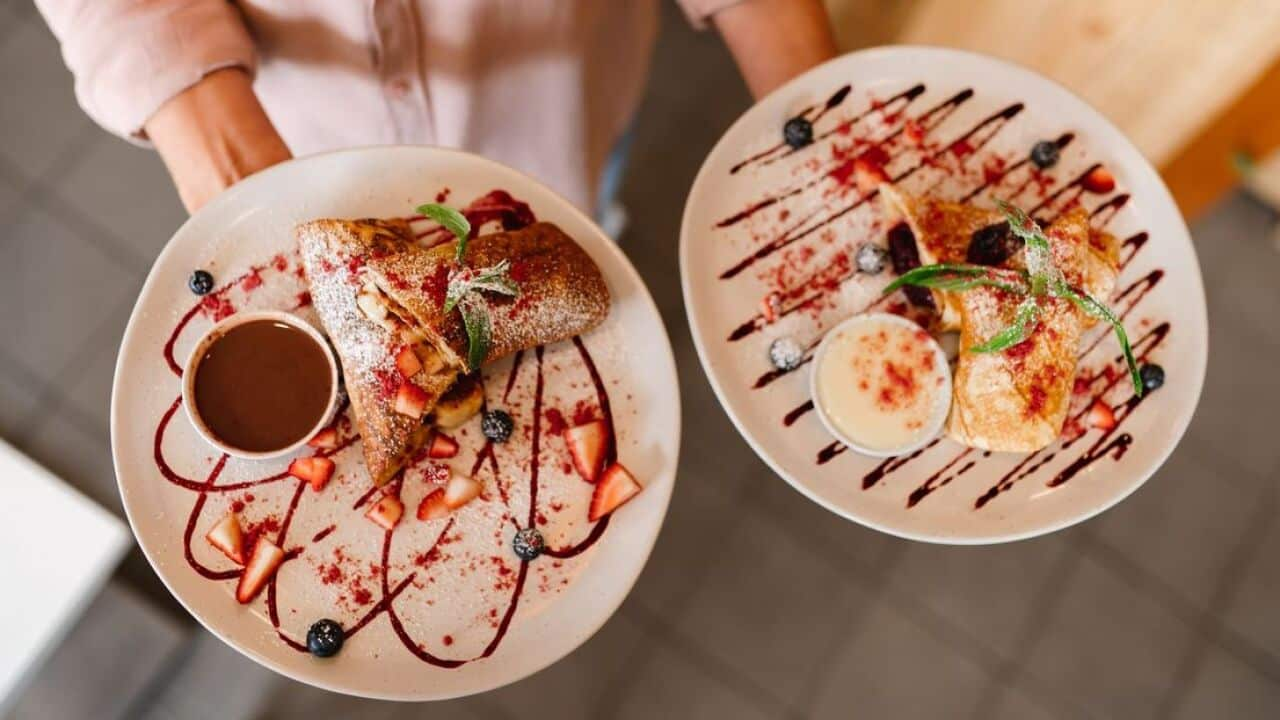From the Brittany region of France and the streets of Tokyo, to the multicultural city of Melbourne, the crêpe has withstood the test of time, geographical barriers and diverse palates.
Délicieuses: The classic French crepe
French cuisine is all about using the right ingredients. As simple as these ingredients are, they need to be the best quality before le savoir faire (skills and artistry), according to Michaël Gatta-Castel and Patrizia Maselli.
Gatta-Castel and Maselli are the co-founders of La Petite Crêperie, a conspicuously red-and-white chequered kiosk on Swanston Street that serves what they describe as "arrogantly French" crêpes.
The two met in Cannes in 2006, where Gatta-Castel introduced Maselli to some local crêperies.
"This sparked the idea to open our own unique version of a crêperie - a blend of authentic French crêpes with a unique Melbourne setting," says Maselli.
Thin and delicate, French crêpes are available in both sweet and savoury varieties. Created in the Brittany region of France hundreds of years ago, the crêpe can be eaten as a main dish, dessert or snack. Traditionally, French crêpes are eaten in restaurants and are filled with gourmet ingredients.
Although the two stay true to traditional French techniques and recipes, they like to use local ingredients and provide takeaway, which is how Melburnians like it.
"In France, it's not unusual to find takeaway crêpes," Maselli says. "We have French music while we're cooking, but our version is in a unique setting. … We use locally sourced ingredients where possible."
La Petite Crêperie offers both sweet and savoury crêpes, with Gatta-Castel and Maselli both admitting that their personal favourites are the sweet ones.
It's a fine art.
"I love the combination of sugar butter flambé with Grande Marnier," Gatta-Castel says.
Maselli adds, "Mine is Nutella and fresh strawberry. It's decadent!"
But to create a perfect crêpe, it all comes down to the batter.
"The batter is made of flour, eggs, milk, and sugar. [The trick is in] finding the right quantities to create the perfect batter," says Gatta-Castel.
Crêpes are spun on a hot plate with great skill and precision to ensure a thin, delicate result. "It's a fine art."
Oishii: The Japanese mille crêpe cake
While French crêpes are like fine art, Japanese crêpes are street food. In Japan, the crêpe is usually sold directly from food stands and is eaten while walking.
If you're in Melbourne, Millé & B patisserie in the Melbourne suburb of Carlton, makes gourmet versions of the Japanese street snack.
Bee Tiew, owner of Millé & B, worked in marketing when she decided to shift to patisserie.
"I studied in Savour Chocolate & Patisserie School in Brunswick. I started Millé & B on the side while I was doing an internship with Kirsten Tibballs; then I went to Paris in 2017 and learned about patisserie for a year," Tiew says.
"To be honest, the hardest bit about going into business was my parents disagreeing with me [about] changing careers."
When Tiew took the plunge, she went all in and turned her side hustle into a brick-and-mortar shop in 2018 that specialises in mille crêpe cakes. She says mille crêpe cakes became popular in Japan in the 1980s. The name means 'a thousand layered cake'.
"The reason why I chose to focus on these cakes was because I saw a gap in the market. I also like the intricacy of it, the assembly. I love how each layer is delicately stacked on top of one another to result in a beautiful tower of crêpes."
Tiew says that every layer of each 20-layered cake has a distinct ingredient and flavour.
"Mille crêpe cakes are made of Japanese crêpes. These crepes have similar ingredients to French crêpes, but they tend to be thinner. They have crispier edges and softer middles."
I love how each layer is delicately stacked on top of one another to result in a beautiful tower of crêpes.
In Japan, people typically eat crêpes as a sweet snack or as a dessert, served wrapped in paper cones. "Originally, Japanese crêpes didn't have savoury options and had toppings like whipped cream, fruits, and chocolate sauce," she says.
Tiew, who has visited Japan a lot "to eat and get inspiration", shares that many of her offerings rely heavily on Asian flavours.
"My favourite is the matcha and adzuki. That's the first cake I created. I enjoy it a lot."
After trying yuzu (a citrus) in Japanese desserts, she now has a yuzu and white chocolate flavour.
Although the crêpe may not have originated in Japan, Tiew admires how the Japanese have made it their own.
"I appreciate the care they put in every delicate layer and how they've been innovative with it."
Melbourne, Victoria
Carlton, Victoria
CREPE APPEAL

Boozy Crepes Suzette








